It’s fall, and time for our favorite Apples: 2021 MacBook Pro teardowns! We’re excited to tuck into these fruits from a branching 2016 timeline—the MacBooks that could have been. While more ports, a durable and usable keyboard, MagSafe, and swapping the Touch Bar for good ol’ function keys all bring the nostalgia, there’s also futuristic Apple silicon and super-retro case stylings. These MacBooks are so cool they blew right past “Plus” on their way to Pro and Max.
This teardown has been updated with the teardown team’s latest findings. If you’re looking for the Polishing Cloth teardown, it’s after all the shiny new stuff.

Right off the bat these Macs are serving early aughts and we are here for it. If the repairability scores match the straight-walled aluminum cases, our little fixer hearts will surely grow three sizes.

Just look at those ports. With so many places to plug things in and so many dongles scorned, Jony Ive must be rolling in his …. Ferrari. MagSafe also makes a triumphant return to the MacBook, despite its iPhone moonlighting—happy news for all the clumsy cord-kickers, the pet owners, and well, most everyone.
But we didn’t come here to ogle the design. They say true beauty is on the inside, so let’s see if it’s true.
X-ray! X-ray! Read all about it!

But before we break out the tools, here’s a see-through preview of the 14” M1 Pro MacBook Pro (great names, Apple, so easy to keep track of these things), from our friends at Creative Electron. The X-ray might look like an angry owl, but don’t worry, it won’t bite. Or … peck. Whatever owls do.
Zoom in on this X-ray and count the 33.7 billion transistors in the M1 Pro package under the heatsink. Go ahead, we’ll wait.
Okay, you can’t count the transistors from here, but you can clearly see there is a lot going on in that package. Elsewhere you can see the faint outline of the metal keyboard frame, with stabilizers over the long keys, as well as the dark magnets in the speakers, trackpad, and fans.
Avengers, disassemble
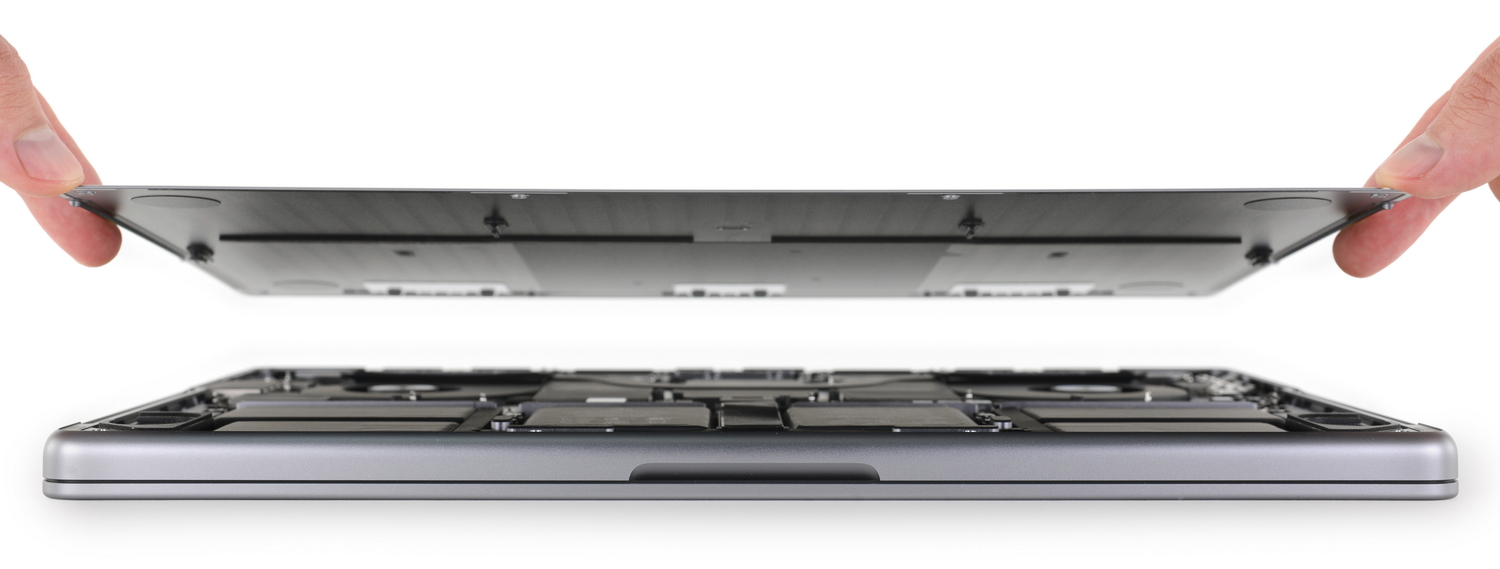
Can you hear angelic music, or is that just us? Sure, the rear case is still secured by discouraging pentalobe screws, but there’s still no adhesive this far in—and the clips are even less terrifyingly tight! Cross your fingers (and spudgers) that the trend continues.
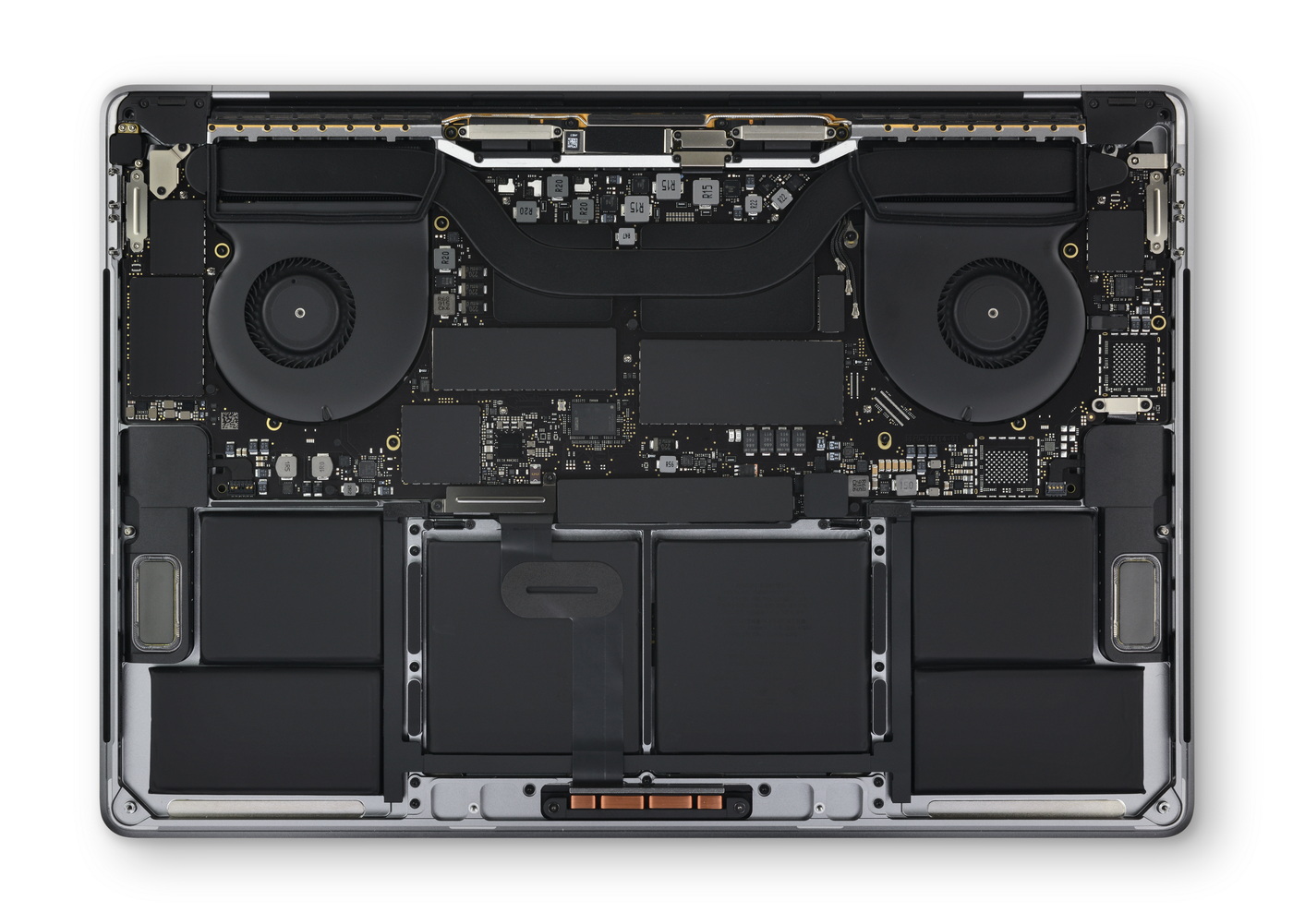
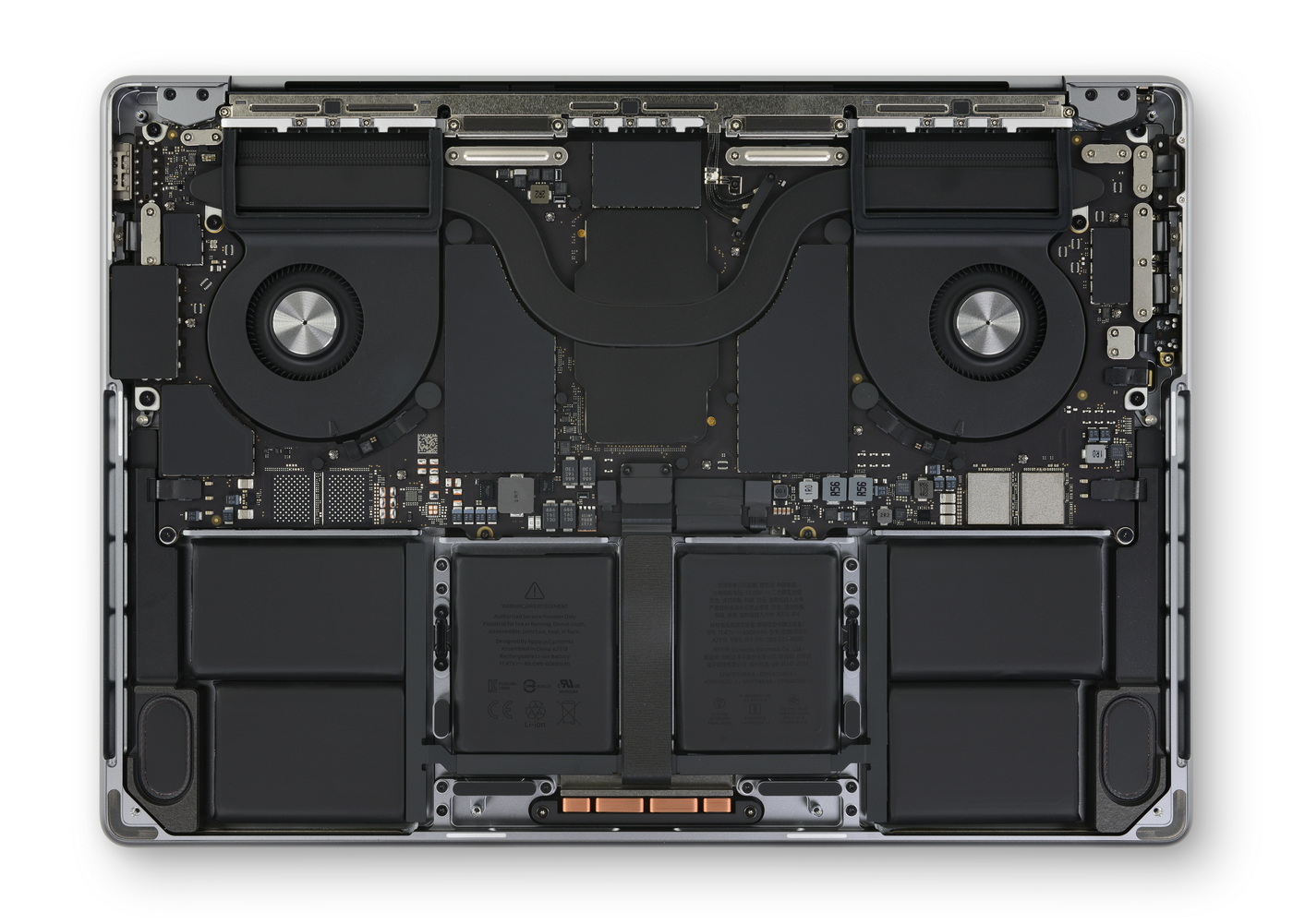
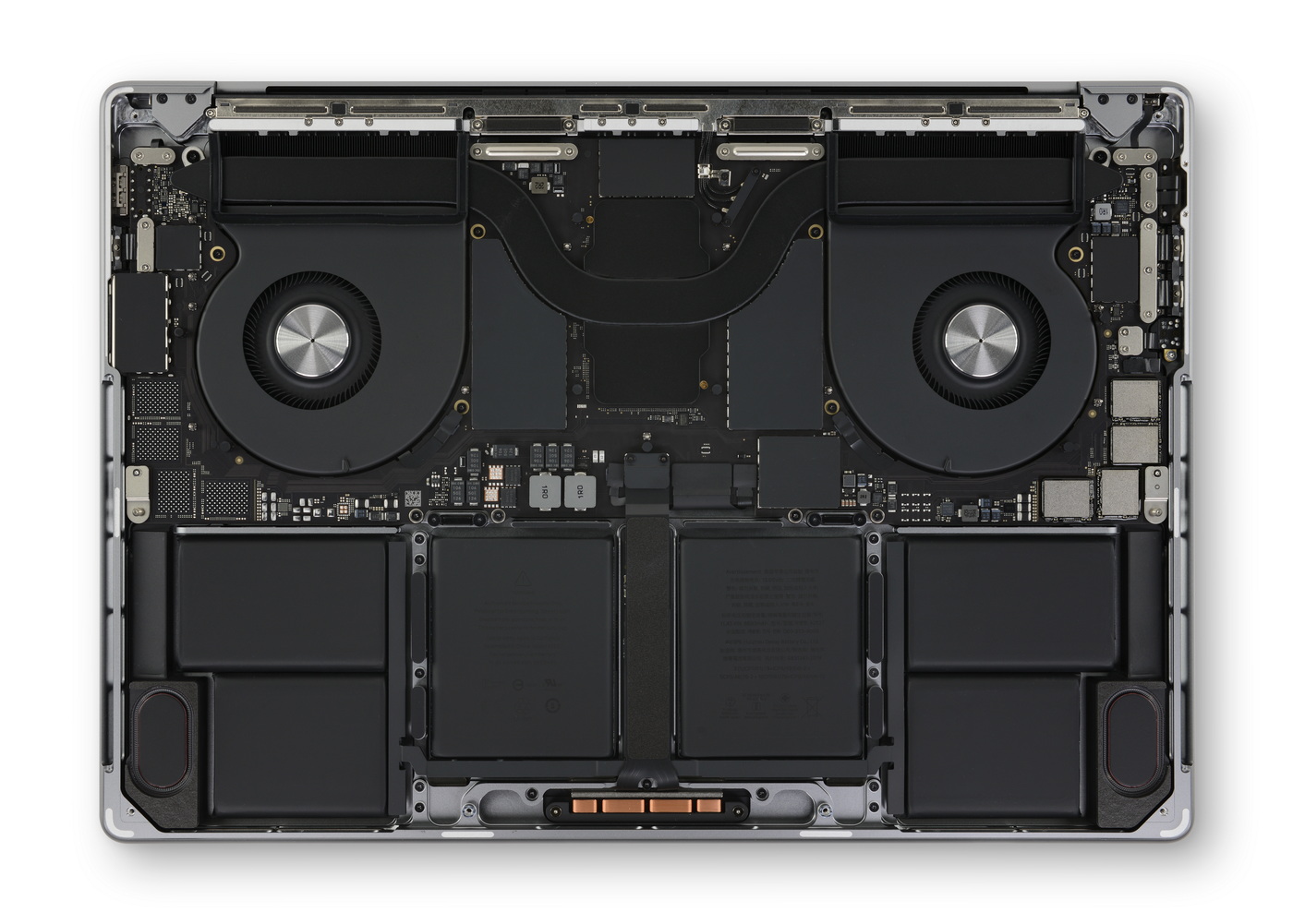
Please act surprised, even if you already saw Apple’s stylized renders of the internals during their keynote. I mean, we started this whole “teardown” thing first, plus our imagery includes all the gritty details, like keyboard and backlight cables. We keep it real, Apple.
It does look like we’re “missing” a couple chips, or, rather, you’ll note some empty solder pads where additional storage would go. Spoiler alert: we didn’t spring for the top-tier specs (We blew most of the budget on polishing cloths). Compared to the 2019 15” Touch Bar MacBook Pro, these models seem to make even better use of interior space. Speakers and batteries fill every cozy cranny, without sacrificing a robust-looking cooling assembly.
Major differences between the 14” and 16” models seem pretty few and far between: different rear cover clips, chip arrangements, and hinge bracket shapes. Feel free to spot the differences on your own, but to our eyes these look like nearly identical designs at different scales. And of course, they look fantastic as always—it’s basically a work of art in there—but, the miserable MacBooks of butterfly and Touch Bar fame shame looked nice in early teardown images, too. It’s time to get excavating to learn more.
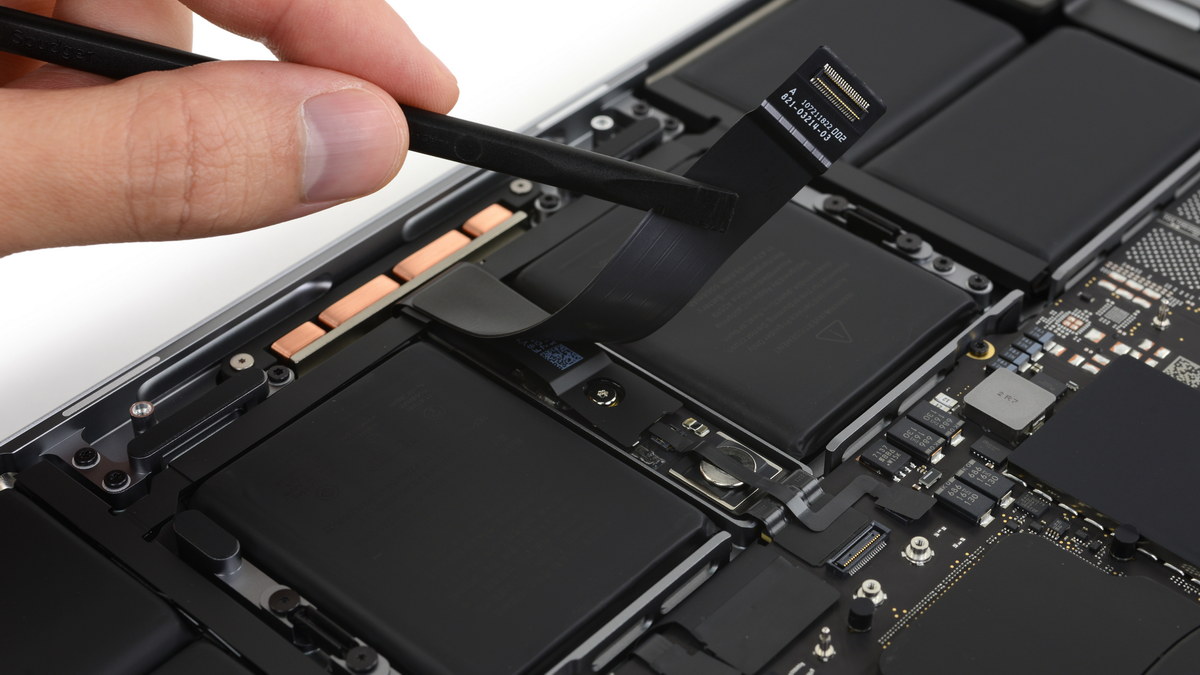
You always want to start by disconnecting the battery—if you can figure out how. After a little exploratory surgery, we found the battery terminal hidden under the big trackpad cable. From there we’d normally leave the battery for last, because removing recent MacBook Pro batteries requires infinite patience, a bottle of isopropyl alcohol, and an optional bottle of human-friendly alcohol. But as we peer into the guts, we notice something unexpected. The wind carries a whisper of three words, a faint utterance that makes our hair stand on end: battery pull tabs.
Y’all really aren’t ready for this battery reveal
The four outer battery cells all sport subtle but noticeable pull tabs, a.k.a. stretch-release adhesive—those thin white strips we know and love from the iPhone and MacBook Air. If your technique is right, you just pull on these things to stretch out the adhesive, and, in theory, whatever’s attached to it falls right out.

Even better, it appears this battery isn’t trapped under the logic board. That could enable straightforward battery swaps without removing all the brains first—a procedure we’ve been dreaming about for a while.
But wait, we don’t see any pull tabs on the two center cells, and they refuse to budge. Are we screwed—or, worse, glued? (It wouldn’t be the first time we’ve found some promising-looking pull tabs, only to be let down.)
This stumped us for a bit, until we had the desperate brilliant idea to remove the trackpad. We hoped for a better look underneath the battery, but got something better.



It turns out there are pull strips under the remaining battery cells, accessed through precise cutouts in the chassis, beneath the trackpad. What do you know—some smart person gave repair and access some thought.

And just like that, the battery is jettisoned. No alcohol. No pry tools. No incessant cursing.
Batteries all spec’d out

This year’s 16-inch MacBook Pro packs a 99.6 Wh battery (11.45 V, 8693 mAh)—a close second to the 99.8 Wh battery in the 16-incher from 2019. The 14-inch Pro meanwhile has a smaller, 69.6 Wh battery (11.47 V, 6068 mAh)—blowing right past the M1 MacBook Pro battery from last year, which clocked in at 58.2 Wh (11.41 V, 5103 mAh).
The icing on this battery cake? Our tests confirm that battery replacements are fully functional and warning-free! (Yes, we ponied up for extra 14” and 16” models to try some parts swaps for you, because we care.)
All eyes on screen
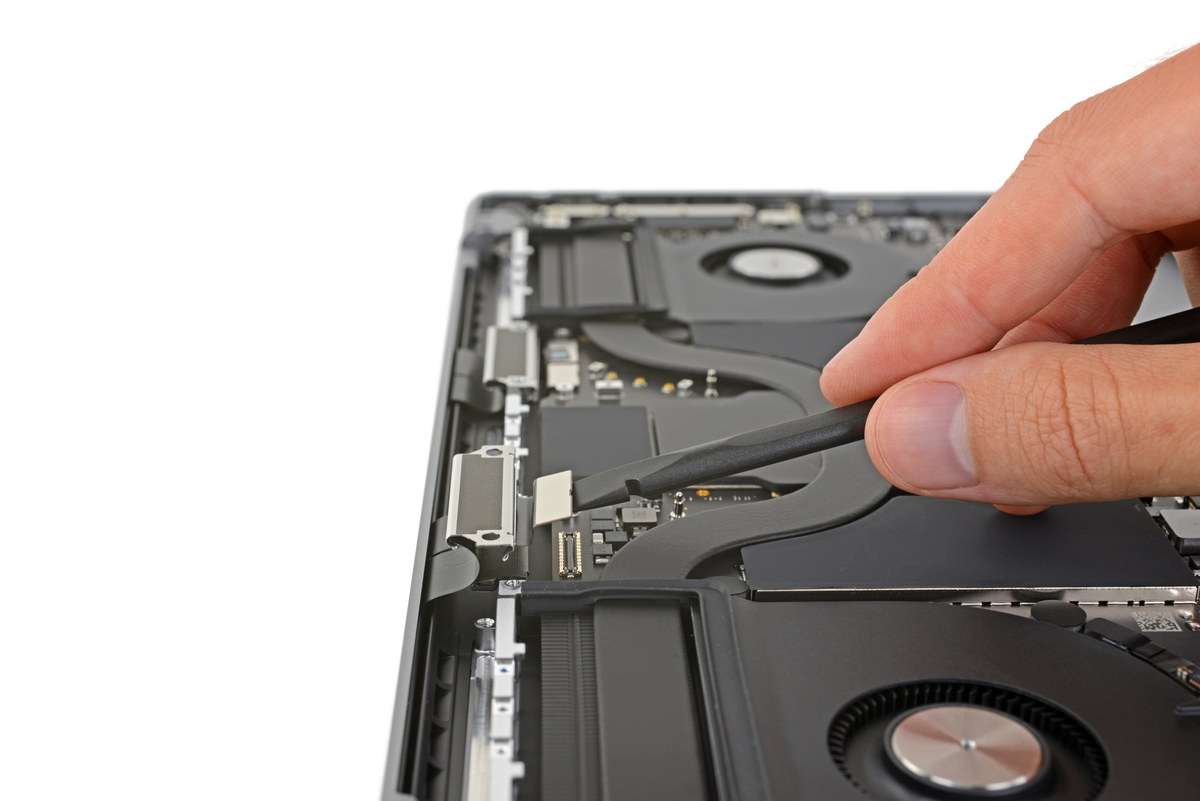

Slack isn’t just on your MacBook desktop these days, it’s in the computer. In the display cables, that is. On the way to detaching the display, we found these cables have been redesigned with roughly 100% more slack—will flexgate truly be a thing of the past? (We need to start a bingo card for all the issues these new MacBooks seem to fix.)
Display replacements have also been streamlined, physically anyway—there are fewer fussy screws, springs, and cables to dispatch, and no more separate display board to extract. But a brief downer before we continue: our tests confirm that DIY display replacements will kill True Tone function. It’s not a foundational feature like Face ID on an iPhone, but it’s still a bummer to lose functionality while trying to restore your device through repair. If you want a 100% complete repair, you’ll have to pay Apple their exorbitant fee (or else demand your right to repair be enshrined in law).

Speaking of Face ID, if you thought surely it would fit right into that display notch, we have news. Here’s a Face ID module from our recent iPhone 13 teardown, alongside the MacBook Pro’s display for comparison. These sensor modules have literally been reaching new heights, and seemingly won’t be squeezing inside that uber-thin display lid anytime soon. That said, there’s a curious amount of space carved out here for a simple webcam. Check out this X-ray of the notch internals:

In this image you can clearly see the camera sensor at the center, with its indicator LED just to the right. At left is (presumably) the ambient light sensor. And then, vast stretches of additional notch to either side. The notch itself remains a somewhat divisive design choice (as it has since its introduction in the iPhone X)—especially considering how slow Apple was to implement the necessary UI accommodations … and still is.
Hello M1 Pro
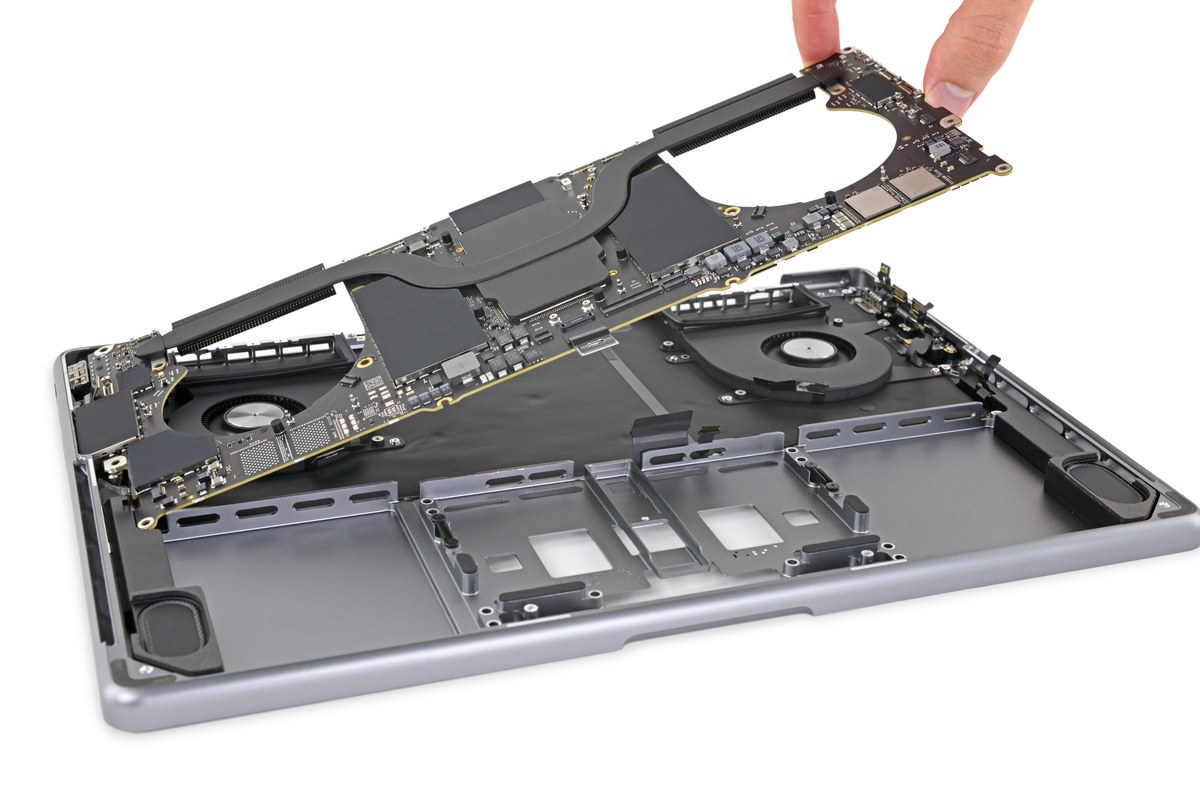

The logic board—and the accompanying heatsink and fans—are beefy, to say the least, and this isn’t even the M1 Max model. Both M1 Pro and M1 Max feature custom system on a chip (SoC) packaging similar to last year’s M1.
The M1 Pro is flanked by two memory modules (four on the M1 Max), soldered up close and personal to the SoC for maximum bandwidth. These memory modules make up Apple’s “unified” memory, meaning they can be shared between the CPU and GPU simultaneously, dramatically increasing the pool that both can draw from.
What does all this fancy-pants unification mean for repairability? Well, nothing great, and we’ve said it before: long-term repair options—or even removal of parts for salvage or recycling—are slim. Everything is on the board. Future-upgradeable RAM? Nada. Better shell out as much as you can afford up-front. Future-upgradeable storage: maybe technically possible, but highly impractical. You’ll either need to put those zippy Thunderbolt 4 ports to work with an external drive, or it’s the cloud for you, baby.


All the Apple chips you can eat
Also known as Chip ID:
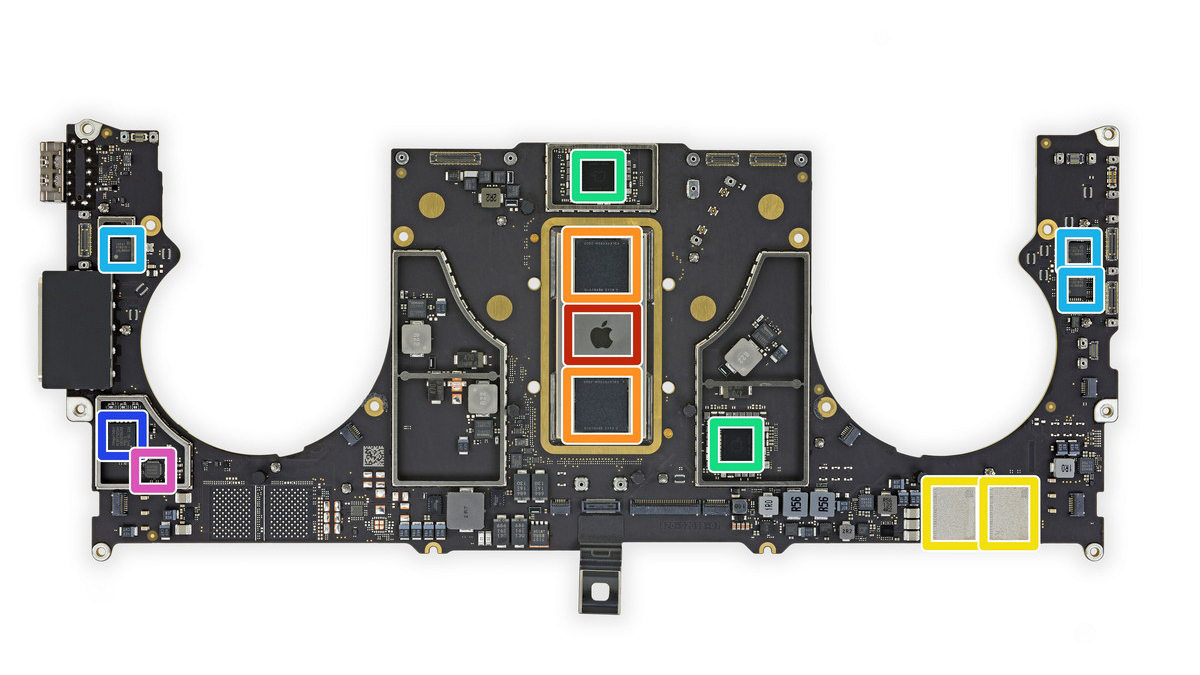
Front side highlights (ROYGBIV order):
- Apple APL1103 M1 Pro system-on-a-chip (SoC)
- Samsung K3LKYKY0EM-ZGCP 8 GB LPDDR5 SDRAM Memory (16 GB total)
- Kioxia KICM225UZ0460 2×128 GB NAND Flash Memory
- Apple APL1098/343S00515 Power Management
- Intel JHL8040R Thunderbolt 4 Retimer
- MegaChips MCDP2920 DisplayPort-to-HDMI Converter
- Genesys Logic GL9755A Card Reader Controller
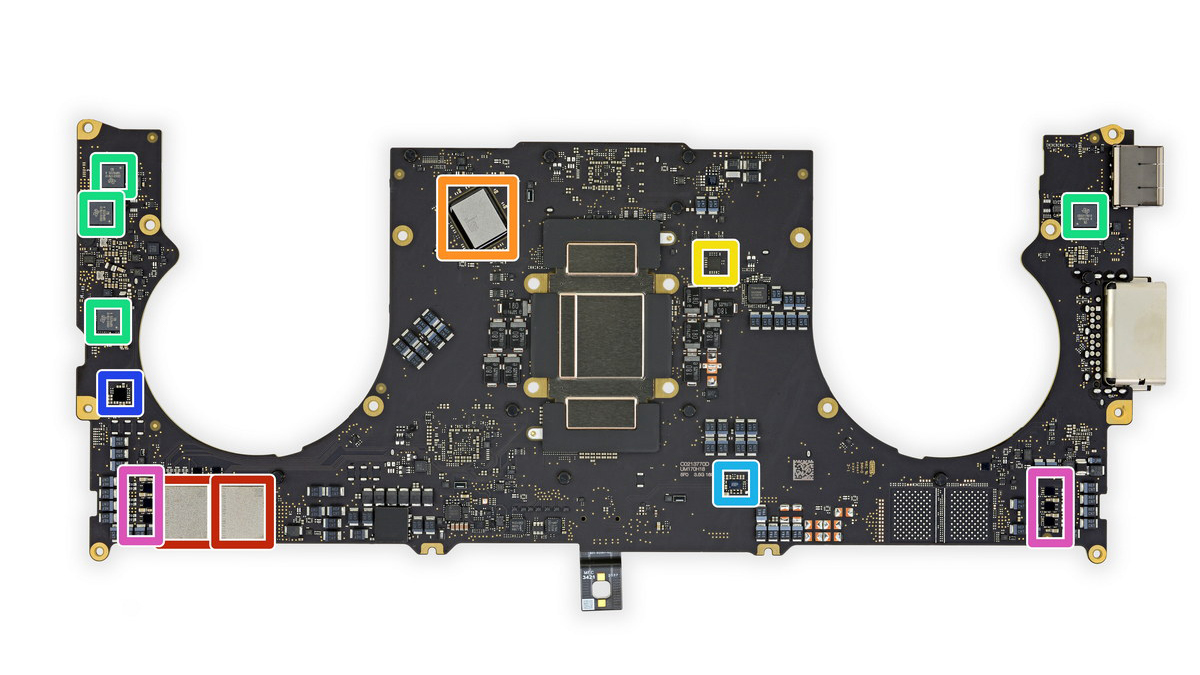
Rear side highlights (ROYGBIV order):
- Kioxia KICM225VF9081 128 GB NAND Flash Memory
- USI 339S00912 Bluetooth/WiFi Module
- NXP Semiconductor SN210V NFC Controller w/ Secure Element
- Texas Instruments CD3217B12 USB Type-C Port/Power Delivery Controller
- Renesas ISL9240 Li-Ion Battery Charger Controller
- Cirrus Logic CS42L84A-CWZ Audio Codec
- Texas Instruments SN012776B0 Audio Amplifiers
If you’re still hungry for chip ID, community member C. Chin has helpfully identified over 75 chips on the motherboard and touchpad! You can find his full chip ID post here.
Bobbing for the rest of the bits

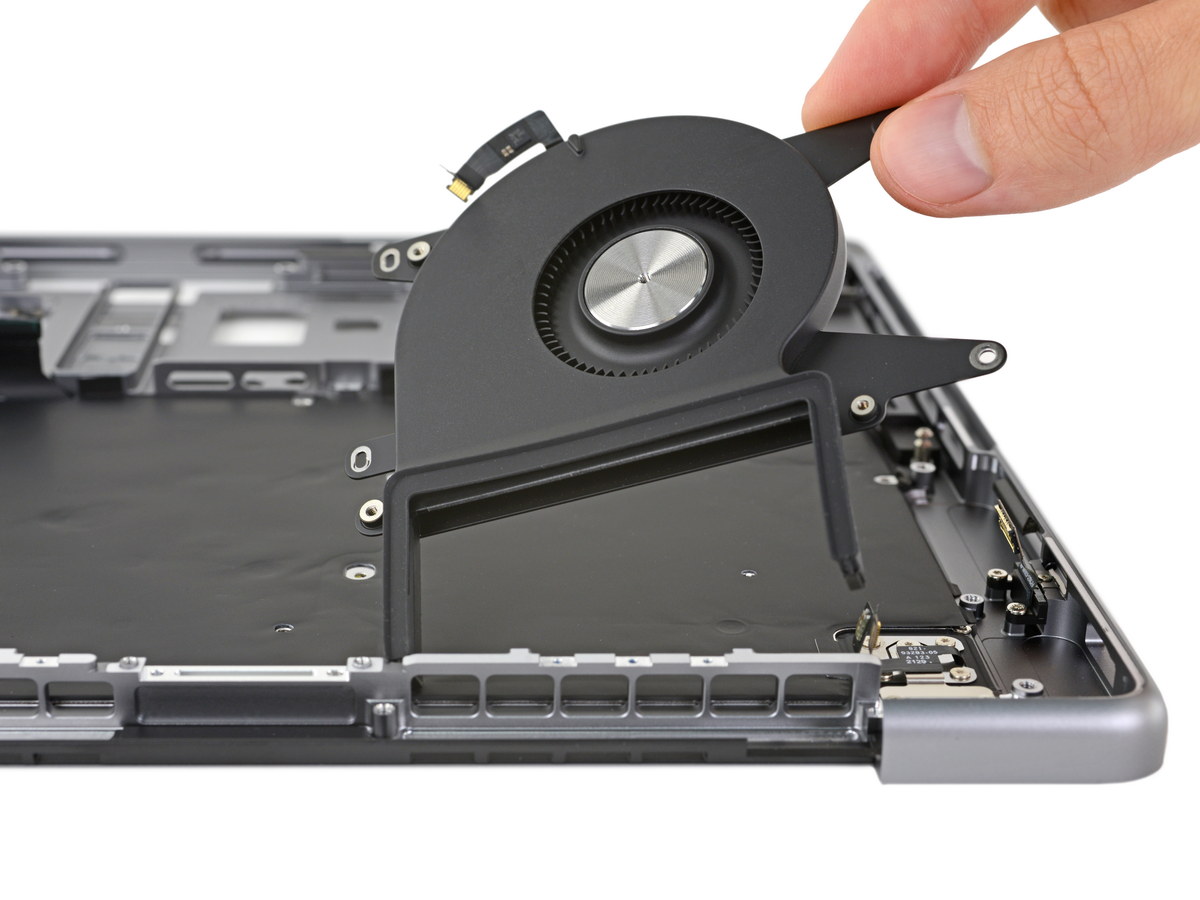

The port situation looks as good on the inside as it does out: most of these ports are highly modular, including the much-loved MagSafe. If they fail, you can swap them out individually, without an expensive board repair. The only exceptions are the SD card reader and the HDMI port, which are quite thoroughly soldered to the logic board. Damage to them means a pricey repair, full board replacement, or else a return trip to Dongletown.
We’re also big fans of the cooling setup, but not as big as these ones. Reviewers say you can barely hear them, but it’s nice to confirm they exist and your laptop isn’t waiting to throttle or cook itself. (Pro tip for reviewers: unplugging the trackpad cable prompts the fans to spin like crazy.) For now, the MacBook Air remains the only Apple notebook with no actual internal fan. In the above photo, the larger Nidec-made fan is from the 16” model, and the other from the 14”.
A keyboard caution

The only thing on this keyboard that’s somewhat convenient to replace is the power button/Touch ID combo, but even then you won’t be keeping Touch ID without paying Apple their fee. The rest of the keyboard remains problematic to replace; Apple stores and AASPs will likely continue replacing your entire top case rather than deal with the hassle of repairing their own keyboard design. (Thankfully it’s not a butterfly affair anymore, so repairs should be far less frequent—just be sure to keep a tight grip on your latte.)
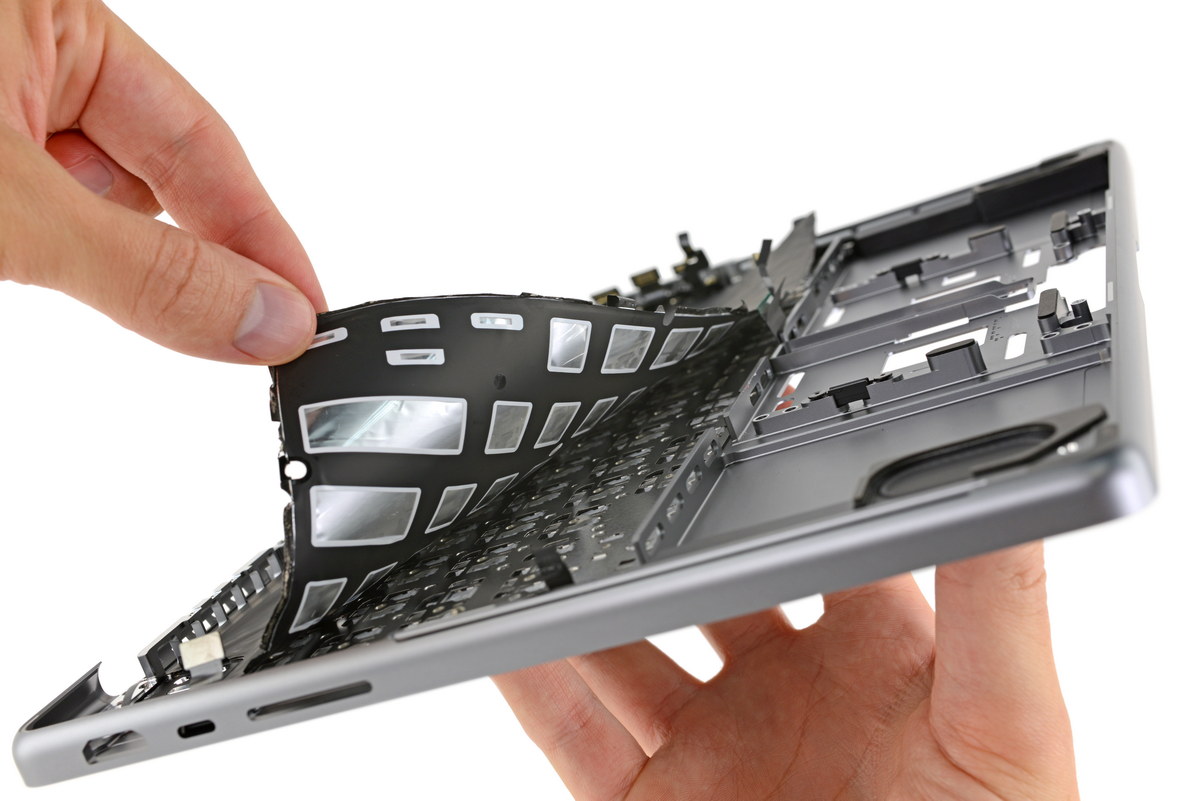
We peeled up the backlight layer to check the keyboard—still screwed and riveted down. The new black keyboard surround isn’t a separate module that drops in, like we hoped—it’s just a new anodized finish, probably purely for cosmetic purposes.
Repairability
Apple’s M1 silicon is rocketing the industry forward in a bunch of ways, and it’s unfortunate repairability isn’t advancing as quickly. Still, this design represents a major move in the right direction. The battery replacement procedure, while far from easy—and certainly very far short of the drop-in simplicity you get in a Framework Laptop or even a Dell XPS—is still vastly improved. May we never again relive the nightmare of surgically removing faulty cemented-in batteries from a “Pro” laptop.
We’ve also griped about soldered memory in the past, and while we still don’t love it, it’s hard to argue with the performance and battery life advances Apple has engineered here. It’s possible you couldn’t get anything quite like this from a socketed design. (Although we’d be curious to know if that was even considered.)
The biggest blight on this machine? Soldered-down, non-removable storage—a major bummer for repairability, upgradeability, security, data recovery, and overall flexibility. This would be difficult to justify in any consumer product, but for professional use it seems like an even bigger misstep. And forget about removing the drive to protect your data during repair or when you sell it; you’ve gotta shred the whole logic board if you want failproof security.
In the end, the new MacBook Pro earns a 5/10* on our repairability scale (10 is easiest to repair):
- Battery replacements are reasonably well prioritized, if not exactly easy.
- Display replacements have been greatly streamlined.
- Many other components are modular and can be independently replaced, including the trackpad, most I/O ports, and fans.
- Repairs are hindered by pentalobe screws, a riveted keyboard, glued-down speakers, and some software barriers.
- Permanently soldered storage is a huge detriment to a “Pro” laptop.
- Apple publishes a free service manual and offers replacement parts for sale to end users.
* Editor’s Note: We initially awarded a repairability score of 4/10, but uprated it to 5/10 after Apple came through with a public service manual and replacement parts.
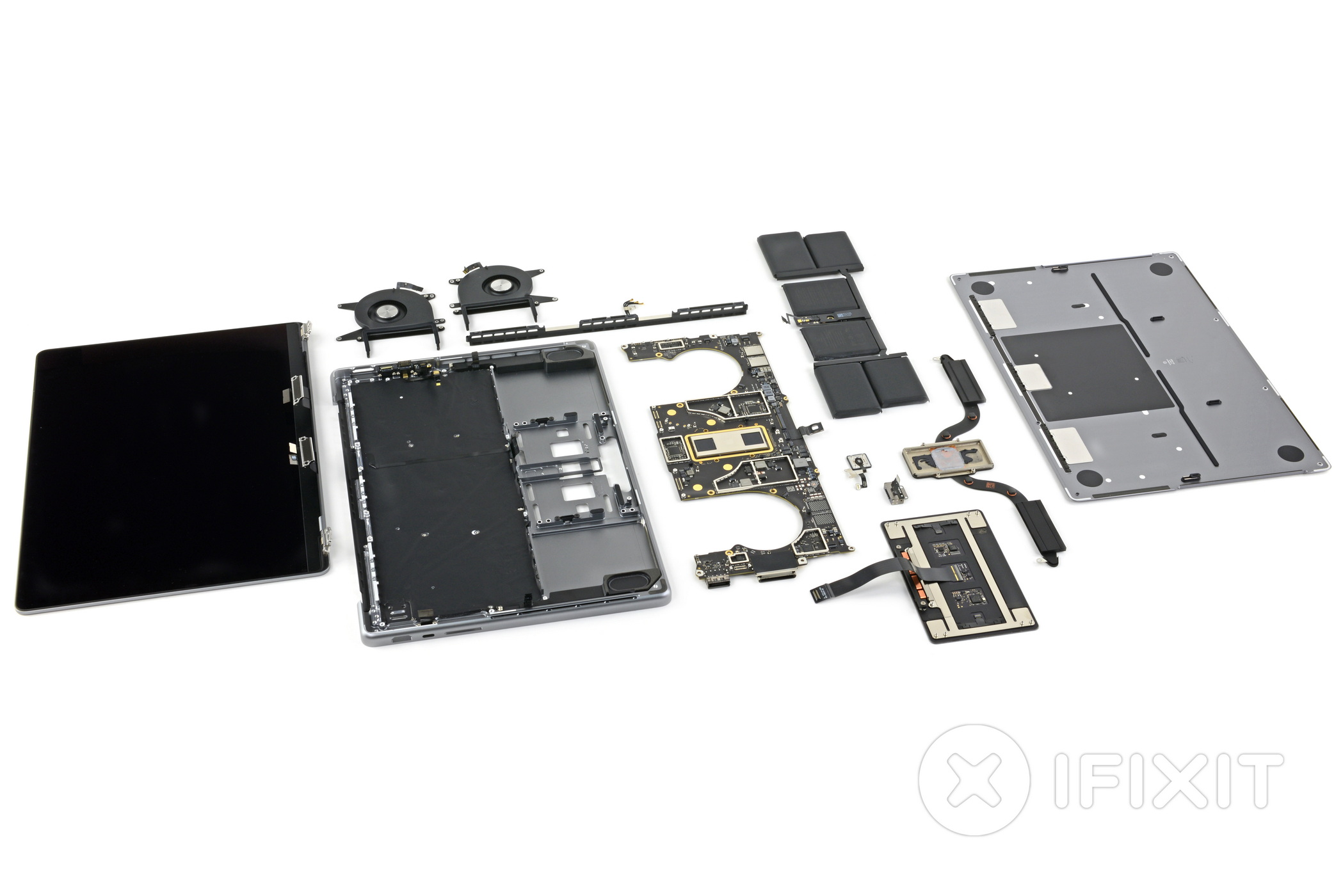
One more thing…
While our primary teardown team spent the week hard at work on the MacBook Pro, our other teardown team was just as busy. The black ops team. They have no names and no budget, and they tear down only the best, the trendiest, the most unobtainable products on the planet. So naturally they went for …
The Thinnest Apple Device Yet: Polishing Cloth Teardown
If you didn’t notice (but who are we kidding—you did), Apple quietly released their own “Polishing Cloth” for $19.
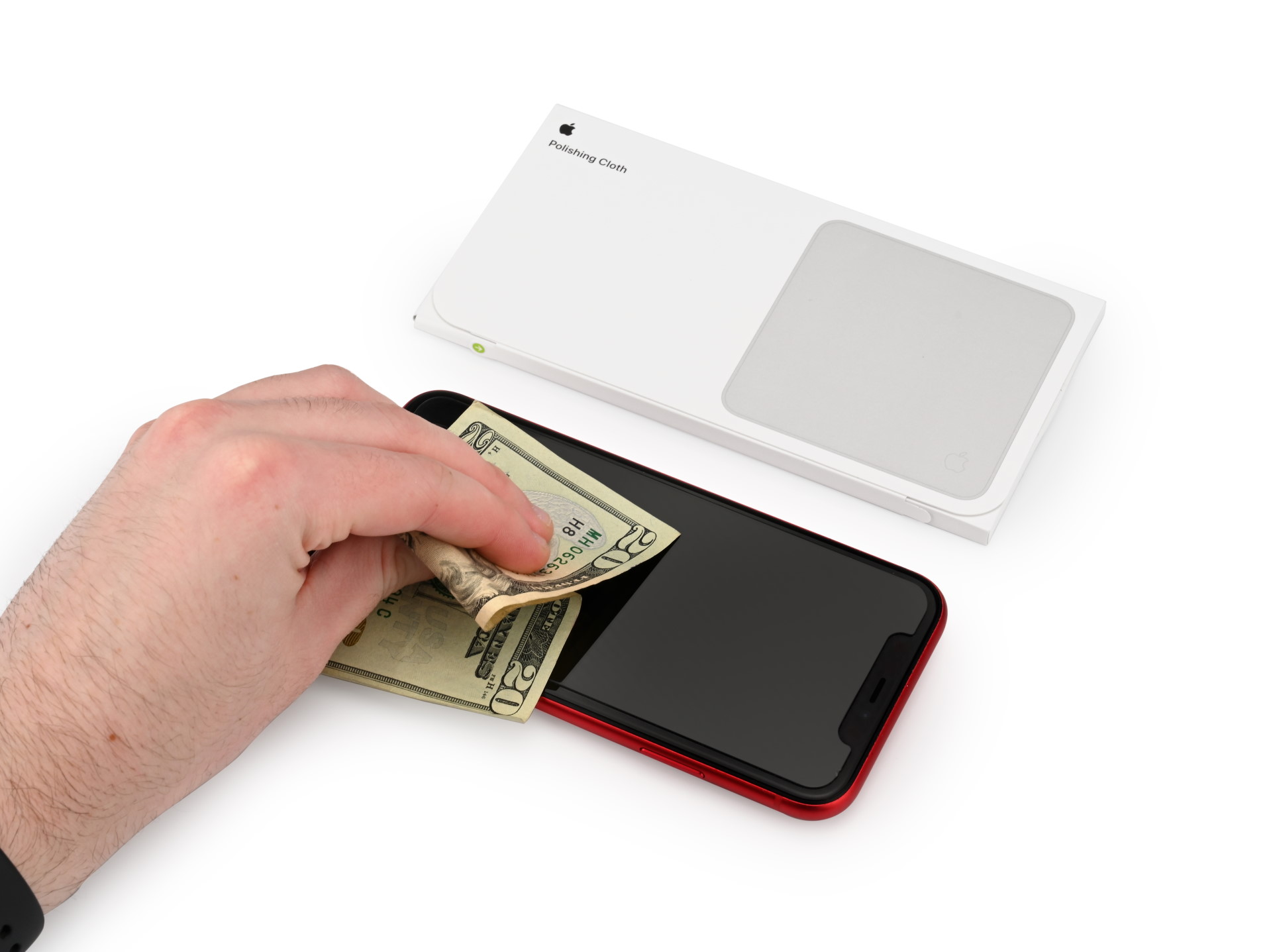
The material feels identical to the inner lining of an iPad Smart Cover, which features a thin layer of microfiber on the inside. Both have a distinct synthetic leather feel to them with a hint of fuzziness, similar to Alcantara.

What else could you buy instead of a singular (su)premium polishing cloth?
- A dongle.
- A Moray Driver Kit.
- Two of our cleaning bundles.
- Eight of our slightly less cool cleaning cloths.
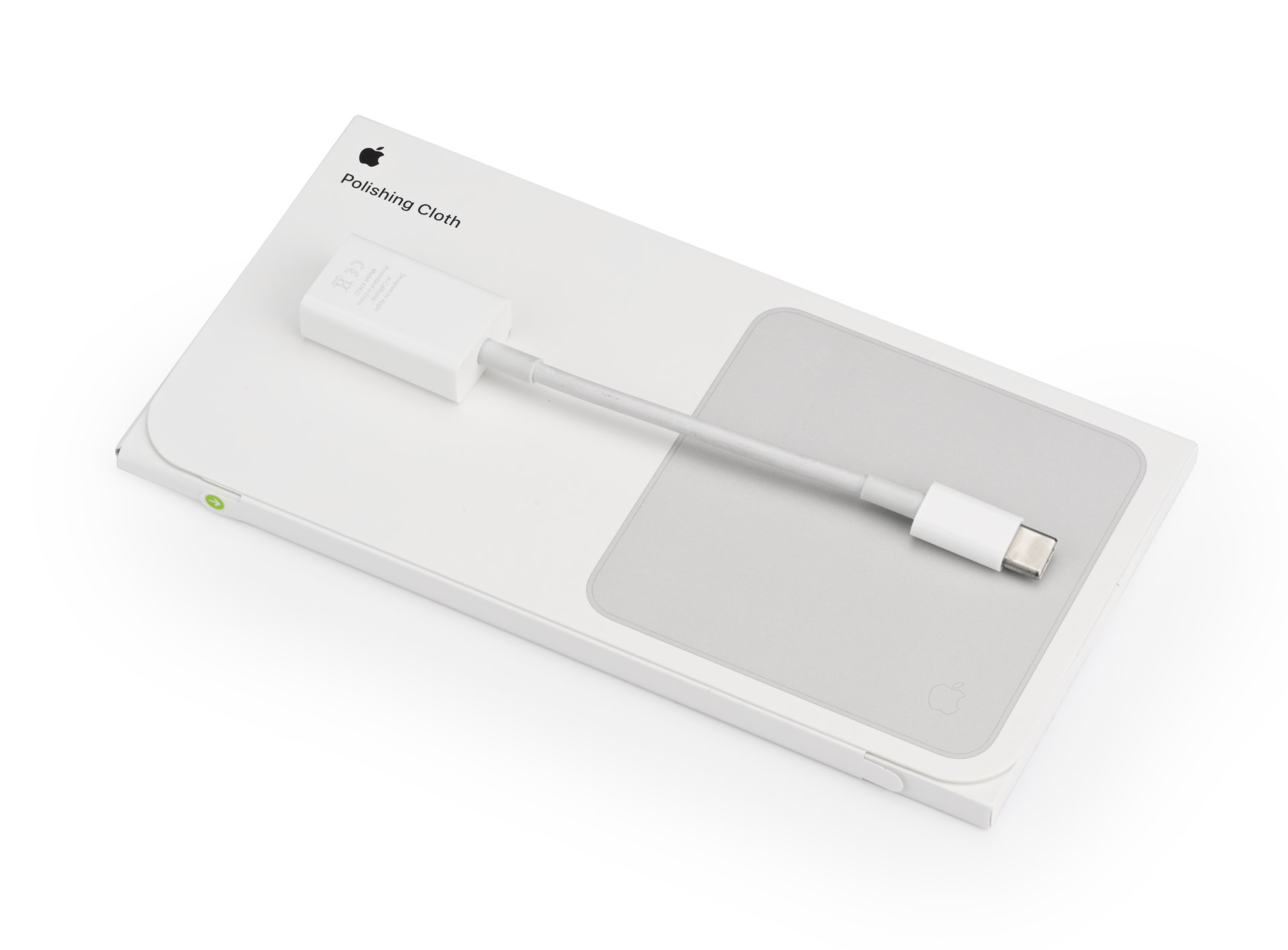


Upon closer inspection, it’s actually two cloths glued together! If you feel a bit underwhelmed by your $19 purchase, pull both layers apart and suddenly you have two cloths, each costing only $9.50.

But let’s go a bit deeper.
Under a microscope the premium quality of Apple’s polishing cloth comes to life. On the left, you’ll see a plain old cleaning cloth. Boring. On the right? Miniscule fibers intricately woven together, uniting to become not just a tool for cleaning, but an object of beauty worthy of being cleaned itself. Amidst the beauty, a thin line delicately traces the form of mankind’s foundational fruit: an apple.

Wait a minute, this is a piece of cloth. What are we doing here? Where did this come from? And where did our twenty dollars go? It’s time to get back to the Mac(Book).
The new Apple Polishing Cloth earns a 0 out of 10 on our repairability scale, for distracting us from a very important MacBook Pro teardown and not going back together after we cut it into pieces with scissors.







78 Comments
Please get to the bottom of the 16” M1 Pro / Max weight difference.
Bigger heat sink than on the 14”?
Rounding anomalies?
Brian B - Reply
I’m sure the heat sink is larger both mass size as well as its radiator fin area between the 14” & 16” systems.
I’m also curious if the heat sink is so different between the M1 Pro vs M1 Max chips in the both 14” & 16” systems.
Remember you can also get the M1 Max in the 14” as well. I’m thinking the Max version has a smaller heat sink (mass) that sits on the chip on the 14” model as the height is less Vs the 16” which offers more space for a higher heat sink (mass) for the Max chip.
Dan -
The M1 Max package is larger than that of the M1 Pro package by a little bit and the cooling contact patch needs to be larger to cover the larger package. Luke Miani compared the two in a video: https://youtu.be/q8F3K7se2ww?t=320
Between that and the physically larger package could cover most of the weight difference between the two.
questionlp -
How does the Display cable compare to the previous Macbooks, especially concerning the cracking of said cable and display issues associated with it. The new display technology must have brought changes cable wise too, right?
Perko M. - Reply
A very valid concern! Stay tuned—we’ll look into it!
Arthur Shi -